|
|
Thiessen Polygon
Thiessen polygons (otherwise known as Voronoi polygons or Voronoi diagrams), are an essential method for the analysis of proximity and neighborhood. Thiessen polygons (cf. figure below on the right side) are used to allocate space to the nearest point feature. It defines an area around a point, where every location is nearer to this point than to all the others (2D). Such kind of structures can be generated also in higher dimensions, whereupon they are called Thiessen polyhedron or Voronoi polyhedron.
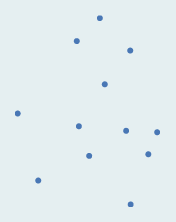 Unregelmässig verteilte Punkte oder Stichproben Unregelmässig verteilte Punkte oder Stichproben |
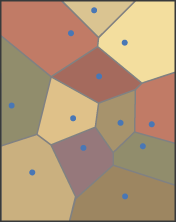 Punkte mit den dazugehörenden Thiessen-Polygonen Punkte mit den dazugehörenden Thiessen-Polygonen |
Voronoi polygons can also be created around lines, which then lead to more complex structures (cf. illustration below). In this unit, the thematic is restricted to the Thiessen polygons for points, the simplest and most common ones. An advanced discussion is provided by Boots (1999).
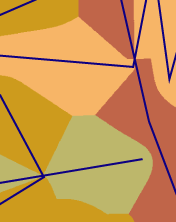 Rasterzellen Thiessen-Polygone konstruiert um Linienzüge
Rasterzellen Thiessen-Polygone konstruiert um LinienzügeThere are various applications possible for Thiessen polygons, due to their organization that is similar to many phenomena observed in nature (plant cells, soap bubbles bumping together) and in geosciences. Jones (1997, p. 48) provided the following example: Thiessen polygons are used to generate soil maps based on irregular distributed sample points. The border between two soil types is assumed to be at the half of the distance between two sample points that exhibit different soil types. It is assumed that there is no further information about the space. Another application of Thiessen polygons is the attempt to model the catchment area of stores.
Construction of Thiessen polygons
|
How can Thiessen polygons be built? The solution is a geometrical approach. A Thiessen polygon encloses all the space which is closer to the associated center than to any other point. It is obvious, that the borders of Thiessen polygons are the geometric places, which have the same distance to two centers. In order to construct Thiessen polygons, all the points are triangulated into a triangulated irregular network. For each triangle edge, the perpendicular bisectors are generated, which form the edges of the Thiessen polygons. The perpendicular bisectors are constructed by drawing circles with radius d around the corresponding points. The vertices of the Thiessen polygon are at the location, at which the bisectors intersect. |
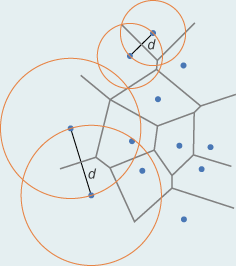 Konstruktion von Thiessen-Polygonen (Haggett et al. 1977) Konstruktion von Thiessen-Polygonen (Haggett et al. 1977) |
|
In raster data model, polygon raster zones are created. These zones show the locations that are closest to a given point (in this case points are represented by raster cells). There is the advantage that compared to vector data models, in raster data models the metric space can be chosen and weighting factors etc. can be included to the calculation. This subject is discussed more in detail in the lesson "Accessibility" of the intermediate level. |
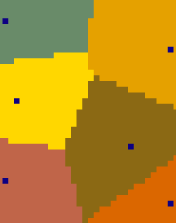 Thiessen-Polygone in einem Raster mit kleiner Auflösung Thiessen-Polygone in einem Raster mit kleiner Auflösung |
